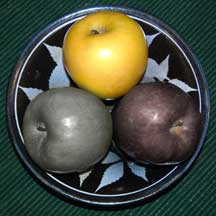 |
We began this discussion of color vision by talking about color defects.
As you think about the most common color defect, a
red-green deficiency, is there anything about it that might present a problem for the Young-Helmholtz theory?
Hint: It has to do with the perception of yellow.
If the perception of yellow comes from stimulation
of “red” and “green” receptors, and a person has a red-green color defect indicating a problem with
“red” and/or “green” receptors, then that person also should have trouble perceiving yellow.
However—and this is a major problem for trichromatic
theory—people with a red-green defect have no difficulty with yellows and blues.
|
Critics of the Young-Helmholtz
theory proposed a variety of competing color vision theories, the most successful of which was suggested by Helmholtz-contemporary
Ewald Hering (1834-1918).
Hering developed opponent-process theory, theorizing
that the eye contains three receptor complexes that each respond in one of two opposing ways.
For example, a red-green complex might be excited by
red and inhibited by green or vice versa, whereas a blue-yellow complex might be excited by blue and inhibited by yellow or
vice versa.
Hering's third opponent process is a black-white complex
that accounts for brightness perception (i.e., is excited by brightness and inhibited by darkness
or vice versa).
Opponent-process theory better accounts
for color defects than trichromatic theory.
For example, because the blue-yellow complex is
presumably intact, a person with a red-green defect should have no difficulty perceiving yellow, which, as we've indicated,
is the case.
Also, the color defects come in pairs, which we
would expect if opponent-process theory is true.
Although most people with color defects have difficulty
distinguishing reds and greens, there are some people who have difficulty distinguishing between blues and yellows.
